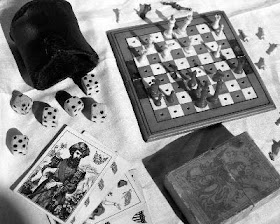 |
| Civil War era set |
Born in Vienna, Maine Bradley grew up in a working-class household in Lowell, Massachusetts after the family moved there in 1847. After completing high school in 1854 he found work as a draftsman and patent agent before enrolling at the Lawrence Scientific School in Cambridge, Massachusetts. He was unable to finish his studies after moving with his family to Hartford, Connecticut, where he could not find gainful employment.
In 1856, he left home and got a job in the locomotive works of the Blanchard and Kimball in Springfield, Massachusetts. After the company was closed during the recession of 1858, he entered business for himself as a mechanical draftsman and patent agent.
 |
| The Checkered Game of Life |
During the Civil War many soldiers engaged in off-duty entertainment including poker or dice games while others amused themselves by reading or playing chess or checkers. The source of many of these diversions were games by Milton Bradley.
Bradley had intended to volunteer for the Union Army himself, but Captain A. B. Dyer, Superintendent of the Springfield Armory, persuaded Bradley that his talents would be better used as a draftsman at the armory than as a private in the ranks. And so he ended up working nights at the arsenal and during the day printed copies of his new game.
The photo below was taken in 1864 just before the Wilderness Campaign and shows then Colonel (later Major General) Martin T. McMahon, assistant adjutant-general of the Army of the Potomac's Sixth Corps, playing the black pieces against another officer.



No comments:
Post a Comment